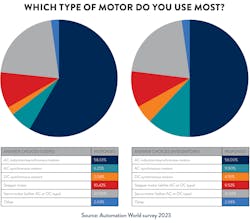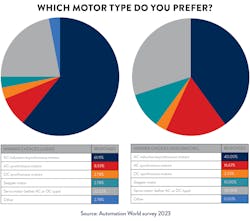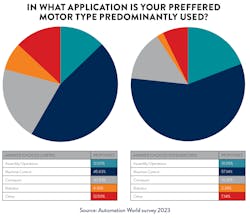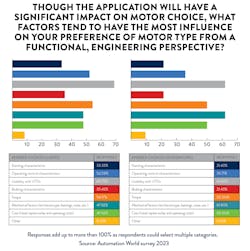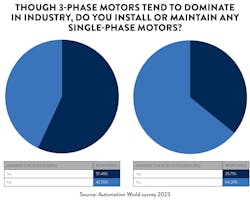Motors: The Core of Automation
Early incarnations of the electric motor first appeared in the 1740s through the work of Scottish Benedictine monk and scientist, Andrew Gordon. Other scientists such as Michael Faraday and Joseph Henry continued to develop early electric motors, experimenting with electromagnetic fields and discovering how to convert electrical energy into mechanical energy.
Thomas Davenport of Vermont invented the first official battery-powered electric motor in 1834. It was the first electric motor that had enough power to perform a task and his invention was used to power a small-scale printing press. But electric motors were not widely used for commercial applications for another 50 years.
William Sturgeon, an English physicist who invented the electromagnet, a coil of wires around an iron core used to enhance the magnetic field, also invented the first DC (direct current) motor that could provide enough power to drive machinery. The first practical DC motor that could run at constant speed under variable weight was invented by Frank Julian Sprague in 1886. It was this motor that provided the catalyst for the wider adoption of electric motors in industrial applications.
The National Electric Motor Association, or NEMA, and the U.S. Department of Energy have long steered industrial motors’ design and manufacturing processes to increase performance and reduce energy use, since these motor systems consume nearly half of the world’s energy.
Among the many innovations of the last 30 years are greater efficiency for induction motors, standardization of design, optimized two-pole design to meet noise requirements, growth of brushless permanent magnet motors, and rigid shaft motors that allow improved airflow and that have increased power outputs by up to 40% within the same motor frame. Power ratings of up to 8,000 hp can now be achieved.
There are four major types of industrial motors: AC induction (also known as asynchronous) and AC synchronous motors, the most widely used, as well as DC synchronous motors and servo motors.
Induction/asynchronous AC motors
Nikola Tesla is credited with the invention and patenting of the first AC (alternating current) induction motor in 1887. The motor commonly consists of two basic parts, an outside stator having coils supplied with alternating current to produce a rotating magnetic field, and an inside rotor attached to the output shaft producing a second rotating magnetic field. The rotor magnetic field may be produced by permanent magnets, reluctance saliency, or DC or AC electrical windings.
The AC induction motor’s popularity is due primarily to its lower cost, efficiency and simplicity. At full load, efficiency varies from 85% to 97%. Squirrel cage rotors are most commonly used with induction motors. Since these motors lack brushes, sparks are not created in the motor and so they can be used in hazardous conditions.
Single- and three-phase induction motors are increasingly being installed with variable-frequency drives (VFDs), offering important energy savings opportunities in applications like fans, pumps and compressors that have a variable load.
Three-phase induction motors are used in a wide range of applications, including lifts, cranes, hoists, large exhaust fans, lathes, crushers, oil extracting mills, textiles, and commercial electric and hybrid vehicles.
AC synchronous motors
An AC synchronous motor runs at a steady state. The rotation of the shaft is synchronized with the frequency of the supply current; the rotation period is exactly equal to an integral number of AC cycles. Synchronous motors use electromagnets as the stator of the motor, which creates a magnetic field that rotates in time with the oscillations of the current. A rotor with permanent magnets or electromagnets turns in step with the stator field at the same rate and provides the second synchronized rotating magnet field.
Common applications for AC synchronous motors, which operate at a constant or synchronous speed from no-load to full load, include high-power and high-speed compressors, blowers, induced and forced draft fans and servo drives.
Synchronous motors are particularly useful for low speed (below 300 RPM) applications because the power factor can be adjusted to unity and hence the efficiency is high. But with the development of solid-state variable frequency drives like inverters and cyclo-converters, they can also be used in variable speed applications.
Synchronous DC motors
DC synchronous motors need a direct current supply for the rotor to generate a magnetic field. These motors have both stator-winding as well as rotor-winding and are found everywhere and in any device that uses electricity to provide motion. In general, DC motors are used as VFDs and for applications in which severe torque variations occur since they have a higher starting torque than AC motors. They are also better able to control speed, especially when working with a heavy load.
There are four types of DC motors: permanent magnet, series, shunt and compound. They are often found in heavy industrial applications such as cranes, air compressors, lathes, lifts, spinning machines, fans and pumps, elevators, conveyors and rolling mills.
Servo motors
A servo motor is a rotary actuator or linear actuator that allows for precise control of angular or linear position, velocity and acceleration. It consists of a suitable motor coupled to a sensor for position feedback. It also requires a relatively sophisticated controller, often a dedicated module designed specifically for use with servo motors.
The term servo motor is often used to refer to a motor suitable for use in a closed-loop control system. Servo motors are generally viewed as a high-performance alternative to the stepper motor. Brushed permanent magnet DC motors are often used with servo motors owing to their simplicity and low cost.
For large industrial servo motors, AC induction motors are typically used, often with VFDs to control speed. Brushless AC motors with permanent magnet fields are a compact alternative, effectively large versions of brushless DC electric motors.
Servo motors are typically found in applications such as robotics, CNC machinery and automated manufacturing.
End User and Integrator Insights
Though motors don’t always receive the attention they deserve—often losing the spotlight to newer technologies such as smart devices, digital transformation initiatives and operations software—no one in industry would dispute how critical they are to the function of nearly every automated system. The centrality of motors to automation means that there is no shortage of opinions in industry about motor preferences.
In Automation World’s survey of industrial end users and system integrators for this report, we looked at:
- The factors that have the most impact on motor type preference.
- The type of motor most widely used in respondents’ operations.
- Preference for specific motor types.
Most used motor
It should come as no surprise that the workhorse motor of industry—the AC induction motor—is also the most widely used motor in industry. Our survey showed that 58% of users and 50% of integrators noted the AC induction motor as their most frequently used type of motor.
Reasons for the prevalence of AC induction motors include their self-starting capabilities, reliability and lower costs. The ability to connect these motors to variable frequency drives—in both their single and three-phase formats—is another reason these motors are used broadly across industry.
The next most-commonly used motor in industry is the servo motor, with 21% of both integrators and end users citing their use of these motors.
After servo motors, stepper motors were the next most-commonly used motor type in industry, with 10% of integrators and end users citing their use. Though stepper motors have advantages in terms of having a long-life span and not requiring complex tuning or a sensor to detect motor position, stepper motors are not known for being particularly energy efficient, have a low power density and can be noisy.
Seventeen percent of integrators noted a preference for AC synchronous motors, while only 8% of users prefer this motor type. Integrators cited AC synchronous motors’ performance and controllability as reasons for their preference, as well as their energy efficiency. End users also noted these motor’s energy efficiency characteristics due to their use of permanent magnets. They also pointed out better torque factors.
In the comments section of the survey capturing why respondents preferred particular motor types, frequent responses for AC induction motors included: robustness, ease of maintenance, wide applicability, simplicity of control, reliability and cost.
For servo motors, the most common reasons for preferring this type of motor included: better controls and parameterization, position accuracy and ease of use.
With regard to AC synchronous motors, users cited better torque characteristics and energy efficiency with permanent magnet types.
Influencing factors
Several motor characteristics ranked highly in our survey for their influence on the motor selected by end users and integrators.
Usability with VFDs (variable frequency drives) for speed control ranked number one among these characteristics, cited by 69% of users and 62% of integrators. Considering the ease with which AC induction motors can be connected to VFDs, industry’s preference for this ability says a lot about the popularity of AC induction motors.
Following VFD use, the next most influential factor on motor selection is torque, cited by 54% of users and 50% of integrators. Because torque relates to the amount of force the motor can provide for an application, such as with industrial robots, presses and extruders. Torque is particularly important for servo motors in their ability to deliver precise movements and accelerate or decelerate quickly.
Cost ranked as the fourth most cited factor in motor determination, with 50% of integrators and 48% of users noting its relevance. This in encouraging in that, despite rising costs, critical performance capabilities still outrank cost factors.
Several users and integrators noted the importance of energy efficiency and lead time/availability in the comments section of the survey related to this question. This underscores the growing importance of sustainability (at least in terms of long-term cost factors) to industry as well as ongoing supply chain issues for devices containing electronic chips.
Applications
To help put our respondents’ motor preferences into context, it’s important to note the industries in which our respondents work. Among end users, 50% work in the discrete manufacturing industries (e.g., automotive, aerospace, electronics), 29% work in batch manufacturing (food and beverage, pharmaceuticals, consumer packaged goods) and 21% work in continuous processing (oil and gas, energy, chemicals). For integrators, 60% work in discrete manufacturing, 43% in batch and 29% in continuous.
Both integrators and end users noted use of AC motors for control of pumps, fans and blowers.
Single-phase motors
One of the most striking differences in response between end users and integrators arose from the survey question around single-phase motors. Three-phase motors tend to dominate in industry due to their predictability, reliability and capability for larger power operations. Despite this, single-phase motors are still quite common in industry because they typically require less maintenance and are less expensive.
According to our survey, 57% of end users cite use of single-phase motors, whereas only 36% of integrators say the same.
For users, the biggest applications of single-phase motors include: small pumps and conveyors, portable equipment and even a juice-making machine. Integrators also noted single-phase motor use with machine tools, fans, exhaust systems and air compressors.
About the Author
David Greenfield, editor in chief
Editor in Chief
Jeanne Schweder
Contributing Editor, Automation World

Leaders relevant to this article:

